Kudichin, a touch of Portugal in Bangkok
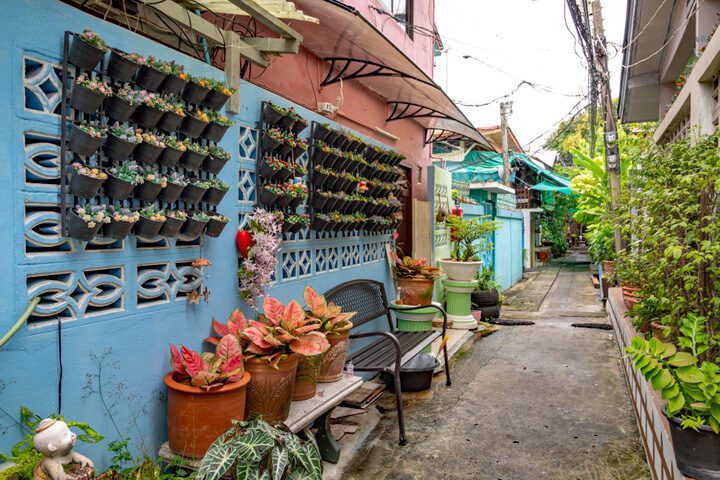
A soi in Kudichin
Ah, Portugal…, how many times will I have been there? Ten, twenty times? The first time was in 1975, a year after the Carnation Revolution and the last time in 2002, after the death of my wife, looking for beautiful memories of the many holidays we spent together.
There are many highlights, I could write a book about it. Let me limit myself to the indisputably top capital Lisbon, where we enjoyed the unique Portuguese atmosphere and delicious dishes from the Portuguese kitchen in many fado restaurants. As I write this, the Portuguese fado singers echo through my living room with their irresistibly melancholic fado music. Portugal is forever my favorite European country.
Portugal in Thailand
I have read enough about the Siamese history and also wrote articles on this blog to know that not only the Dutch have been active in the Ayutthaya period. The Portuguese also had a trading post there, even before the heyday of the VOC.
Now I discovered that in Thonburi - the first capital after Ayutthaya - there is an entire Portuguese district on the west bank of the Chao Phraya. I needed to know more about that and I found a lot of information on the internet. But before I say anything about that part of the city, I will describe the history of the Portuguese in Siam, which shows how Kudichin – that's the name of that neighborhood – came about.
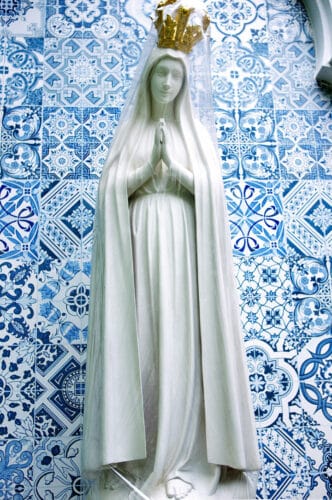
Virgin Mary with the typical blue Portuguese tiles on a house in Kudichin in the background
The Portuguese in Siam
Portugal was an important country of explorers at the time. During the reign of King Manuel I (1469 – 1521), the small maritime kingdom of Portugal set sail to discover the far reaches of the world, it was the Age of Discovery.
In 1498, Vasco da Gama became the first man to sail from Europe to India. Then, In 1509, Afonso de Albuquerque (1453 – 1515) conquered Goa on the western coast of India, followed by Malacca in 1511. Using Malacca as a base, the Portuguese reached the East Indies (East Timor) and the coasts of China (Macau) . Since Malacca was a vassal of Siam, the Portuguese immediately sent an envoy to Ayutthaya in 1511 to assure the king that the Portuguese had no aggressive intentions against Siam.
After further negotiations by two more envoys, a commercial treaty was concluded in 1516, after which Portugal was able to establish a trading post at Ayutthaya, just south of the walled city. The Portuguese bought spices, pepper, rice, ivory and wood from Siam. In return, Siam imported muskets, cannons, gunpowder, ammunition, copper, Portuguese tiles and Chinese silk from the Portuguese. The treaty also included the provision of mercenaries in the service of the king of Ayutthaya and the introduction of European military tactics for the Siamese army.
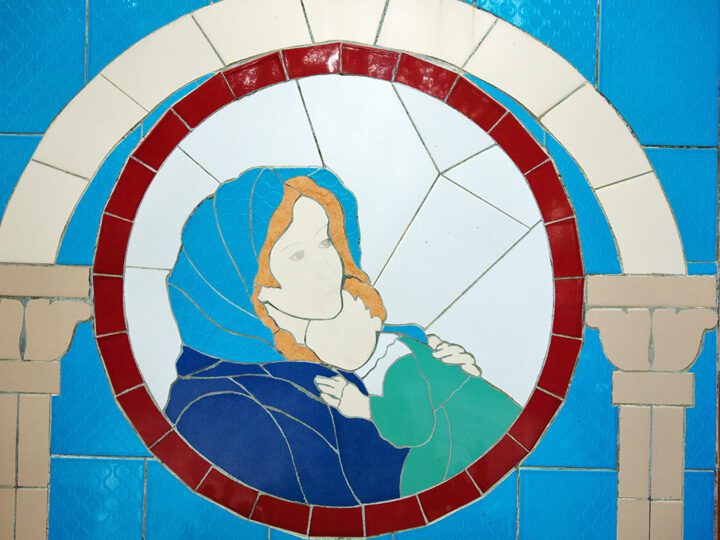
Virgin Mary with baby Jesus on a wall in Kudichin
farang
The entry of the Portuguese into Ayutthaya must have caused an uproar among the Arab, Indian, Malay and Persian merchants who controlled the trade. What did they call the Portuguese?
The word is of Arabic origin and dates back to the First Crusades in the late 11th century. The first crusaders were Franks from Gaul (modern France), the Arabs called them Alfaranja.
Later, when other Europeans joined the Crusades, they were referred to by the same name, which gradually meant Europeans in general. When the Portuguese arrived in Ayutthaya, they too were called alfaranja by the Arab, Indian and Persian traders who had been there long before. The Siamese then adapted it to "Farang" to denote all Europeans or whites.
The fall of Ayutthaya – the Thonburi era
In 1765, the Burmese army invaded Siam, capturing city after city up to Ayutthaya, which fell and burned in 1767. Phraya Tak (Taksin) escaped from the burning city with an army of 200 men. They went to Chantaburi, where Phraya Tak raised a large army with the help of the Chinese community there.
Phraya Tak consolidated his forces in Thonburi on the west bank of the Chao Phraya River and counterattacked against Burma from there. In a period of 6 months he drove the Burmese out of the country. In 1768 he ascended the throne as King Taksin in the new capital Thonburi.
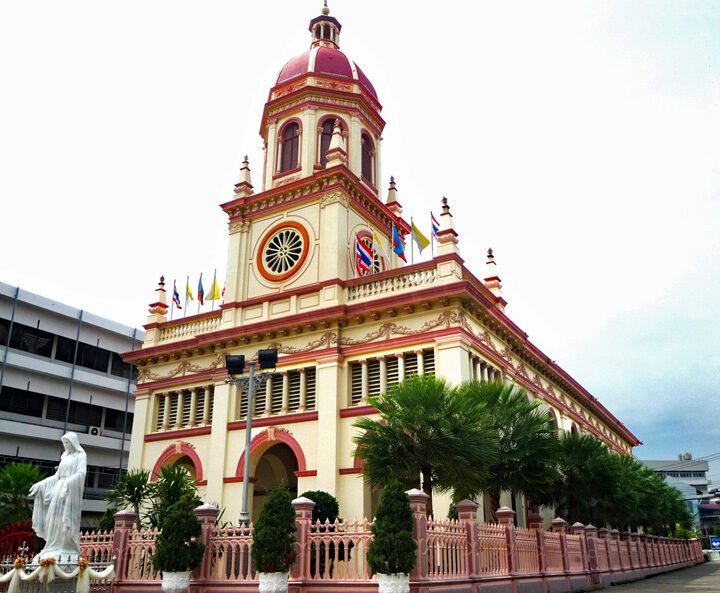
Santa Cruz church
Thon Buri
The Portuguese gave military support to Taksin during his campaigns against Burma and their loyalty to the king was not forgotten. King Taksin had his palace, Wang Derm, built at the mouth of the Yai Canal. The Chinese Buddhists and the Muslims were allotted a piece of land. On September 14, 1769, the Portuguese received a piece of land in the area east of the Buddhist quarter, which also granted permission to build a Roman Catholic church. The church was named Santa Cruz.
The Kudichin community
The land that King Taksin gave to the Portuguese and other Siamese Catholics was in an area called Kudichin. The Portuguese who now lived in that district are therefore called "Farang Kudichin". The Santa Cruz Church became the center of Kudichin's predominantly Catholic community. Later the Santa Cruz kindergarten, the Santa Cruz Suksa school and the Santa Cruz convent were also built. Today, descendants of the first Portuguese residents still live there, who try to preserve old customs, culture and Portuguese dishes.
The present-day neighborhood of Kudichin
It is a typical Thai neighborhood of Bangkok, nice to stroll through narrow sois, where you can now and then taste a touch of Portugal on the outside of houses, thanks to the use of the Portuguese blue azulejos (tiles). Of course the Santa Cruz church is the center of the neighborhood. It is not the original church, which was made of wood, but newly built in 1916.
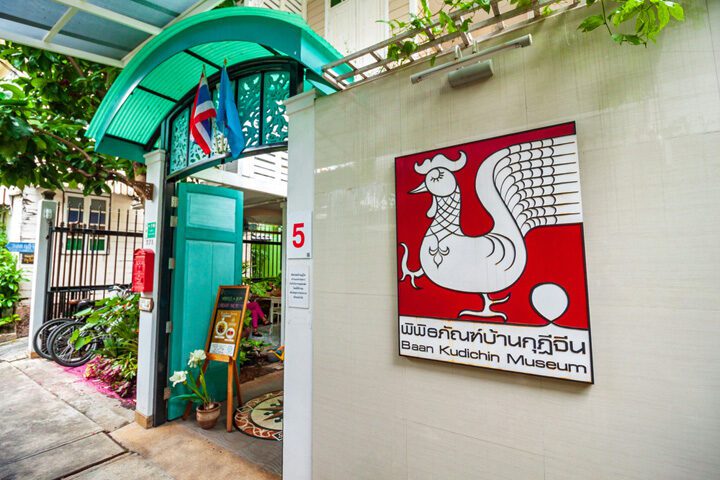
Baan Kudichin Museum
Baan Kudichin Museum
To learn more about Portuguese-Thai history, the Baan Kudichin Museum is the right place. Located in a "normal" house, there is a coffee shop on the ground floor, but on the second floor it becomes clear how the community of Kudichin came about after the war around Ayutthaya. Many beautiful images and also all kinds of objects, which still date from the old days. The museum has its own website, where you can find more information.
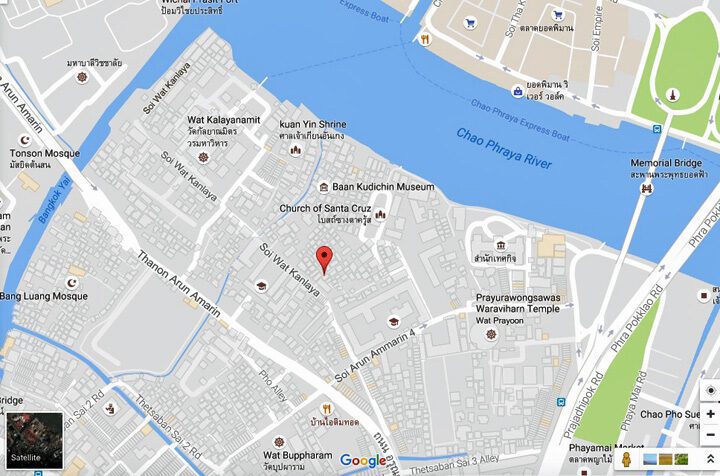
Portuguese restaurants
Well no, there are no real Portuguese restaurants, but some coffee shops and small restaurants try to incorporate a touch of Portugal into some dishes. For example, there is Baan Sakulthong, which, in addition to Thai dishes, serves “kanom jeen” in Portuguese style as a main course. It is a noodle dish, where rice vermicelli is covered with minced chicken in red curry and mixed with coconut cream.
Finally
Kudichin is nice for a (half) day trip. On the Internet you will find a lot of information about the district and how to get there. I haven't been there myself yet, but as soon as I know that there is Fado music to listen to, I immediately travel.
Below is a nice video, where you can see how a day trip can be made:


Well, a wonderful story, Gringo, which shows how varied Thai culture is. You described it well.
I visited that neighborhood a few years ago. On the map you see the ferry that you transfer to the other side for 5 bath. I visited those coffee shops and the little museum up there and talked to the lady owner. She told about her ancestors, Portuguese, Muslims, Europeans and Thais. It is wonderful to walk through those alleys. More interesting than Wat Arun or the Grand Palace. Nice and quiet too. The real Thailand, I always say….
See my response, Tino. I agree with you and mention you in my comment.
Definitely nice to visit when I have walking friends over again. Thank you.
I discovered this neighborhood by chance in 2012. I've been to this neighborhood several times to stroll around in the small creep-by-crawl-through streets. Also striking are the images on the front doors with Christian texts such as “I can do everything through Him who gives me strength” (Jesus Christ is meant here) or “God's blessings be yours every day”. I made some nice pictures of these front doors. You will also find street art paintings on the walls here.
This neighborhood is one of my favorite places in Thailand, and can be easily combined with a visit to Wat Arun. I agree with Tino Kuis, the real Bangkok/Thailand. I'll be in Thailand for a few weeks soon and will definitely be visiting again.
Indeed a beautiful neighborhood in Thonburi. It is nicely located between 2 less touristic but very beautiful temples. You can start your walk at 1 of these temples and then walk partly along the river via Kudichin to the other temple.
Nice! I have only been a Portugal fan for two years now. Maybe also nice to share in the weekly Dutch “Portugal Portal” newsletter? Portugal Portal [[email protected]]
No problem, Tony!
The story (with acknowledgment may be published
on Portugal Portal, complete with photos.
Along with Banglamphu (minus Khao San Road), Kudichin is my favorite neighborhood in Bangkok. You can also walk to Wat Arun from the Santa Cruz church. A very nice walk along and through authentic streets and bridge a wide "klong" over an iron footbridge.
I share your love for Portuga, Gringol; lived for a while near Lagoa in the Algarve and often think of it with 'suadade' and also miss the grilled sardines on the quayside at Portimao.
Interesting that you trace the origin of the word 'farang' to the name of 'alfaranja' by Eastern traders, which was later corrupted by the Siamese to 'farang'.
Until now I knew two other theories about the origin of the word 'farang', namely from the Sanskrit word 'farangi' for strangers and the second theory is that it comes from the word 'faranset' which refers to the French or francophone Belgians with whom the Siamese had many diplomatic but also commercial contacts around the turn of the century.
I like diversity, there is also plenty to find in Thailand. I've never been to this area before, but I think it would be fun to wander through. 🙂